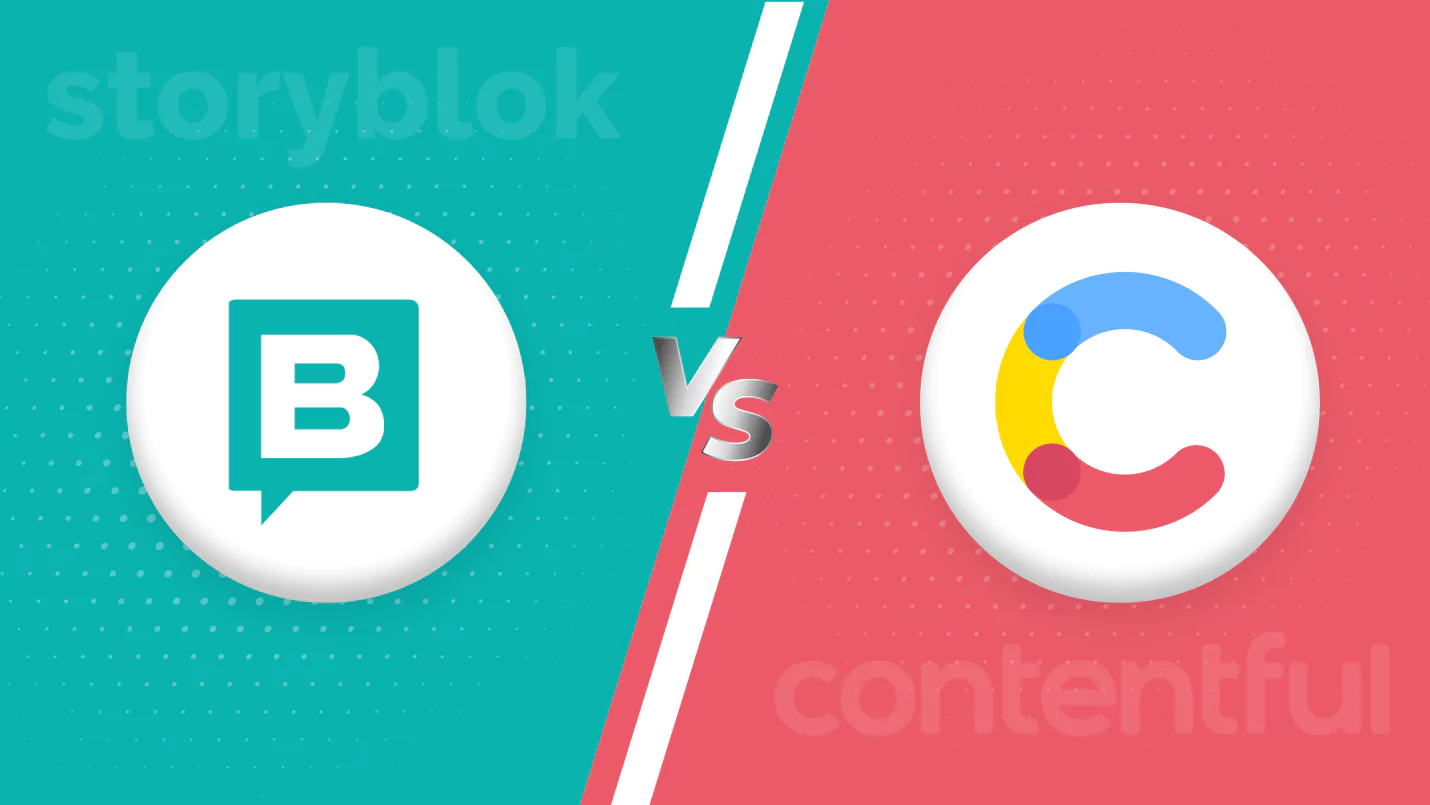The main difference between Storyblok and Contentful is that while both offer free plans, only Storyblok offers free trials of its more premium plans—but there are, in fact, many things different between each platform.
Across the Internet, there are over 79 million websites that are powered by a content management system (CMS), with 74% of brands that use a traditional CMS planning to switch to a headless CMS in the next two years to be more agile to changing consumer preferences, channel opportunities, and changing technologies. If you are considering a headless CMS, that choice could be between major players such as Storyblok and Contentful or others such as Strapi.
In this guide, you will find a full comparison between these platforms to help business owners, digital content creators, marketers and developers to choose between Storyblok and Contentful to choose a headless CMS that suits your specific needs, including a comparison across:
- Ease of use
- Adaptability
- Scalability and performance
- Security and uptime
- The balance of comprehensive features and budget limitations
Traditional vs Headless CMS
In the headless vs traditional CMS comparison, a traditional CMS such as WordPress is an all-in-one solution to manage the content and appearance as you create, organize, publish and manage a variety of digital content (blog posts, product pages, eBooks, etc). A traditional CMS is optimized to deliver content one way, resulting in struggles with content delivery and consistency across diverse channels and devices in an ever-evolving digital landscape.
A headless CMS such as Contentful and Storyblok separates the front-end (appearance) from the back-end (content) to make content reusable across an endless number of digital channels (web, smartphones, social media, etc), allowing developers to choose the front-end frameworks and languages to best support and optimize delivery. Most headless CMS are hosted SaaS. Learn more about our top headless recommendations.
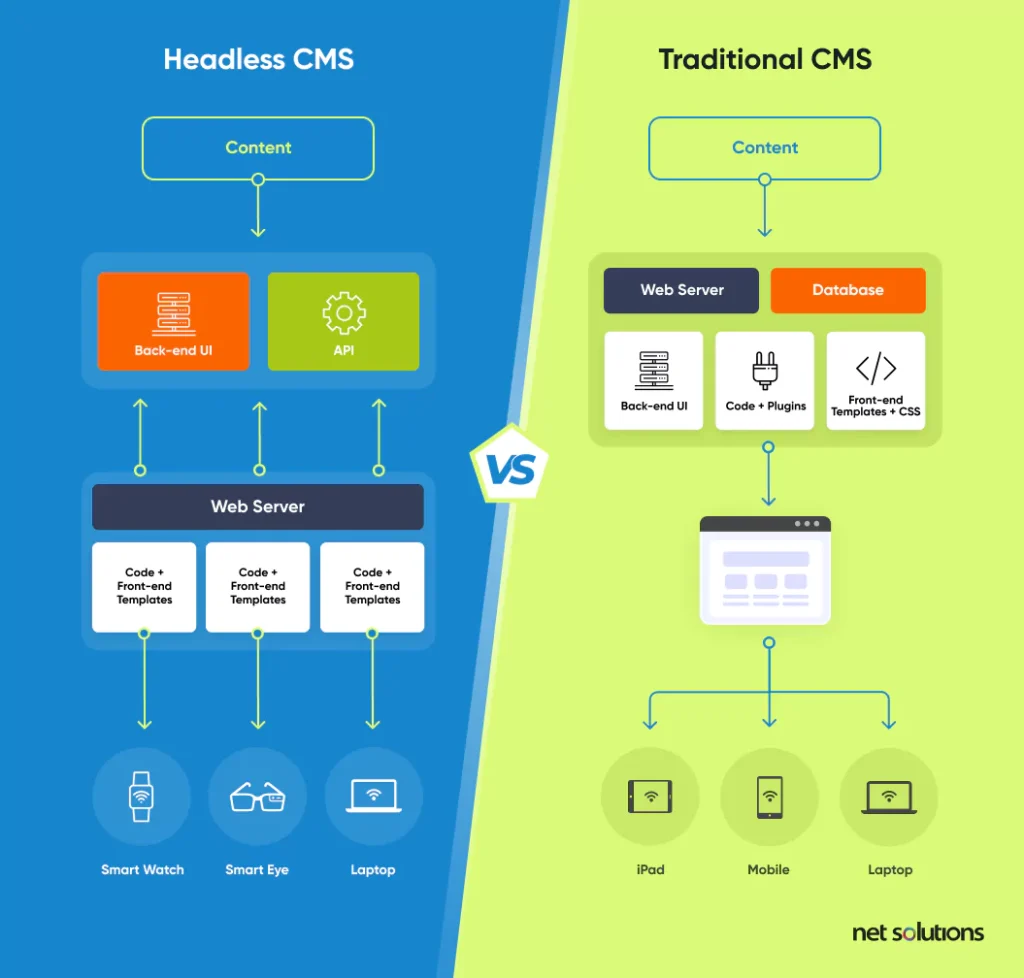
In order to better understand how to choose a headless CMS, let’s look at Storyblok and Contentful in detail.
Storyblok Overview
Storyblok markets itself as “your way to modern content,” a composable, headless CMS to quickly build omnichannel retail strategies and content experiences through an easy interface for developers and content creators. Storyblok customers include Tesla, Adidas, Netflix and Renault and was named “Customers’ Choice” for Web CMS in 2023.
Key features of Storyblok
Here are some of the core features of Storyblok and their purpose:
- Visual Editor with Built-In Collaboration
Storyblok’s Visual Editor is designed for ease of use and collaboration, with the option to create content visually or with “form only,” an option that uses blocks that editors then fill out. Both options come with live preview, drag-and-drop of content blocks, and a familiar rich text editor. - Content Model
The Storyblok content model supports complex content structures using:- Content type: a template or outline for how content is structured in a space
- Fields: these are the pieces of that content (the type of data included), arranged to Schema
- Stories: content entries
- Spaces: a unique database of content with unique content types, entries, and assets. Usually you only use one space.
- Asset Management
Storyblok wants to make it easy to manage assets as well as content, with folder structures and a search to keep all assets easy to find and use. - Localization
Storyblok supports folder level translation and separated content trees to manage multi-language content. Localization applies to everything: text, URLs, SEO metadata and responsive images and can be extended with third-party apps. - Powerful APIs
Storyblok is API-first, supported with many APIs:- Content Delivery API v2 to deliver content to display (REST)
- Content Management API to create or update content (REST)
- GraphQL API to retrieve content in read-only for fast display
- Webhooks
Webhooks notify developers when content changes, with the number of webhooks available depending on price tier.
Benefits of using Storyblok
Storyblok is chosen for a number of reasons including:
Development flexibility
Like other headless CMS, Storyblok allows developers to choose the tech stack of their choice, but Storyblok offers a variety of resources and SDKs in its “technology hubs” specifically for Next.js, Nuxt, React, Vue, Astro, SvelteKit, Remix and Gatsby designed to help developers get started quickly. There is also a strong Discord community for everything Storyblok.
Comprehensive integrations
Storyblok has a rich Technology Ecosystem of integrations (via field plugins, custom sidebar applications or tool plugins) to connect with external systems seamlessly. Some of these integrations are included at elevating pricing tiers.
Advanced collaboration features
The Editor features built-in commenting, discussions and collaboration at each block level, including the ability to set roles and assign work (at Business plan and above).
Seamless device responsiveness
As a headless system, developers can ensure that content is optimized for each front-end, with in-line Live Preview that demonstrates responsive previews for tablet, mobile and desktop devices.
Strong usability features for content
Storyblok’s Visual Editor is easy to use and available as part of the core platform, bringing in preview and drag and drop capabilities alongside a “modular” structure for pages and layouts that streamlines content creation while also enforcing guardrails for brand consistency.
Enterprise-grade security
Storyblok is ISO 27001 certified (as a CMS, not just a data center), based on code reviews, access control, anomaly detection and regular testing. Base security features include regular penetration test, firewall and threat detection. Hosted on Amazon AWS, data center security can include SOC 1, SOC 2, PCI DSS, or FedRAMP. Different price tiers open up new security capabilities to enforce MFA, manage or customize roles, and backup at different frequencies.
Available on AWS Marketplace
The March 2024 announcement of availability on the AWS Marketplace is a new benefit, streamlining procurement and billing and opening up access to various third-party services in the AWS marketplace to increase the availability to enhance the platform with security enhancement, analytics and more.
Drawbacks of Storyblok
Some of the challenges from technical and non-technical users with Storyblok include:
Initial setup complexity
Setup will be a challenge for any developer unfamiliar with headless CMS, and each platform has its own learning curve to accommodate how it manages the content model, how granular the APIs are, the availability of integrations and more. In this sense, Storyblok has a lot of capabilities, but also a nearly overwhelming amount of documentation.
Challenges with customization
Despite the fact that components are meant to be reusable, and there are many integrations, some ‘standard’ integrations are notably missing (e.g. no CRM integrations), requiring more developer time to make these integrations. There are sometimes challenges when the (extensive) documentation also gets out of date.
Development limitations
Although Storyblok markets itself for modern mobile apps, developers say that it is more challenging to work with Storyblok for non-website content, noting there are fewer APIs and developer features for this area.
Rapid deployment issues
A steep learning curve is a top challenge with any headless CMS, Storyblok included, with some users reporting some challenges with setting up and using templates and understanding the approach to the data mode. All of this can slow down launch, unless you use a trusted partner who has significant experience building in Contentful.
Storyblok pricing
Storyblok has many 5 tiers of pricing, starting with a free plan, quickly jumping to three tiers of large business and enterprise plans. Storyblok offers a free trial on its Entry and Business accounts. Storyblok is also available on the AWS Marketplace, consolidating billing and management.
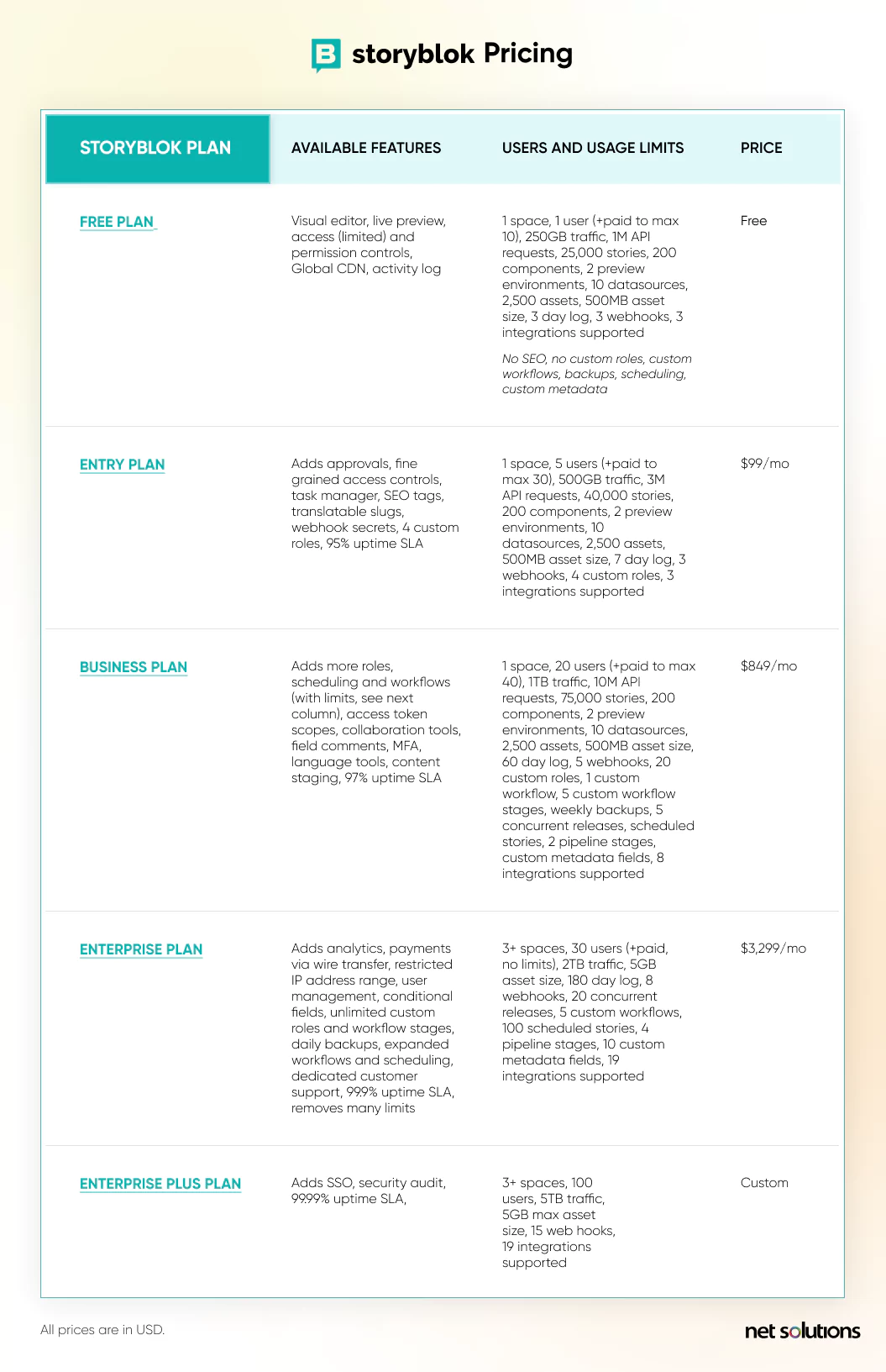
Contentful Overview
Contentful is a composable, headless CMS that markets itself as a “composable content platform for digital-first businesses,” helping deliver on omnichannel retail experiences from a single, structured source of content truth. Contentful works on helping content creators create “experiences” and developers ensure integrity as new experiences are assembled and deployed across channels. Contentful supports almost 30% of Fortune 500 companies such as KraftHeinz, KFC, DocuSign, Ruggable, Vodafone and BMW.
Key features of Contentful
Here are some of the notable features of Contentful and their purpose:
- Content Model
The Contentful content model supports complex content structures to help make content reusable. You can create your content model in the Visual Modeler or manually. Content is organized by:- Content type: a template or outline for how content is structured in a space
- Fields: these are the pieces of that content (the type of data included)
- Spaces: a unique database of content with unique content types, entries, and assets. Usually you only use one space.
- Content Studio
A paid add-on product, Content Studio, leverages patterns, design tokens and a drag-and-drop canvas to help create experiences faster, with a friendly interface and without use of developer time (while still maintaining integrity). - Artificial Intelligence (AI)
The Contentful AI is integrated into both the Platform and Studio to help build content models, streamline content development, translate content, and automate workflows. - Localization
Contentful supports multi-region delivery via “Locales,” AI, third-party integrations. Overall, Contentful boasts support for 100+ languages. - Rich Text Editor & Live Preview
Similar to the traditional what-you-see-is-what-you-get (WYSIWYG) editors, Contentful’s Rich Text editor makes it easy to format text and preview it live. Content in created in pure JSON rather than HTML. - API-first
Contentful’s API-first approach ensures developers and designers are working on the same content source of truth, supported with many APIs:- Content Delivery API (CDA) to retrieve content to display
- Content Management API to create or update content
- Content Preview API (CPA) to retrieve unpublished content
- Images API to retrieve and/or transform images
- GraphQL Content API to retrieve published and unpublished content using GraphQL
- User Management API to manage users
- SCIM API to manage memberships and teams
- Webhooks
Webooks notify developers when content changes occur in a way that does not impact web performance. The AWS webhook is Premium plan only.
Benefits of using Contentful
Here are some of the reasons for considering Contentful development services:
Powerful tools for developers
Contentful offers a variety of software development kits (SDKs) for Java, JavaScript, Python, PHP, .NET, Objective-C and Ruby, and provides Next.js starter templates designed to help developers get started quickly.
Seamless integrations
Contentful has a rich Marketplaceof integrations to connect with external systems seamlessly.
Enhanced content collaboration
Contentful supports real-time collaboration with simultaneous editing capabilities and rollbacks, comments, annotations and more. The Contentful Tasks app from the Marketplace can be used to assign work to colleagues or teams and support the content pipeline from creation (Compose app) to deployment (Launch app, Basic Plan+).
Contentful community
Community support is active on Discord, which offers more real-time collaboration than a traditional forum, and there are extensive resources for developers.
Security
Contentful data centers are ISO 27001 compliant, with encryption, firewall, threat detection, backup and brute force protection. The higher tiers can also access SSO, static webhook IPs, reporting, PCI DSS compliance, additional / custom roles.
Performance
Contentful uses global content delivery networks (CDN) Fastly for JSON and CloudFront for improved performance and scalability. You can view performance and uptime here.
Drawbacks of Contentful
Here are some of the drawbacks associated with using Contentful:
Ease of use
Some of the best features for making Contentful “easy to use” are available only with the paid Contentful Studio add-on, which includes drag-and-drop features.
Launch speed
A steep learning curve is a top challenge with Contentful due to its workflows and the need to ensure the data model is correct. All of this can slow down launch, unless you use a trusted partner who has significant experience building in Contentful.
Trial options
The free plan is very limited, in terms of both features and significant limits and restricted overages, so there is no availability to ‘try’ the Basic or Premium product beforehand.
Here’s a valuable insight for you - Learn about the 10 key metrics to measure how Contentful works for your business.
Read MoreContentful pricing
Contentful has two products: the Contentful Platform, which has a free plan and two paid tiers, and the Contentful Studio, a paid add-on (custom price per year).
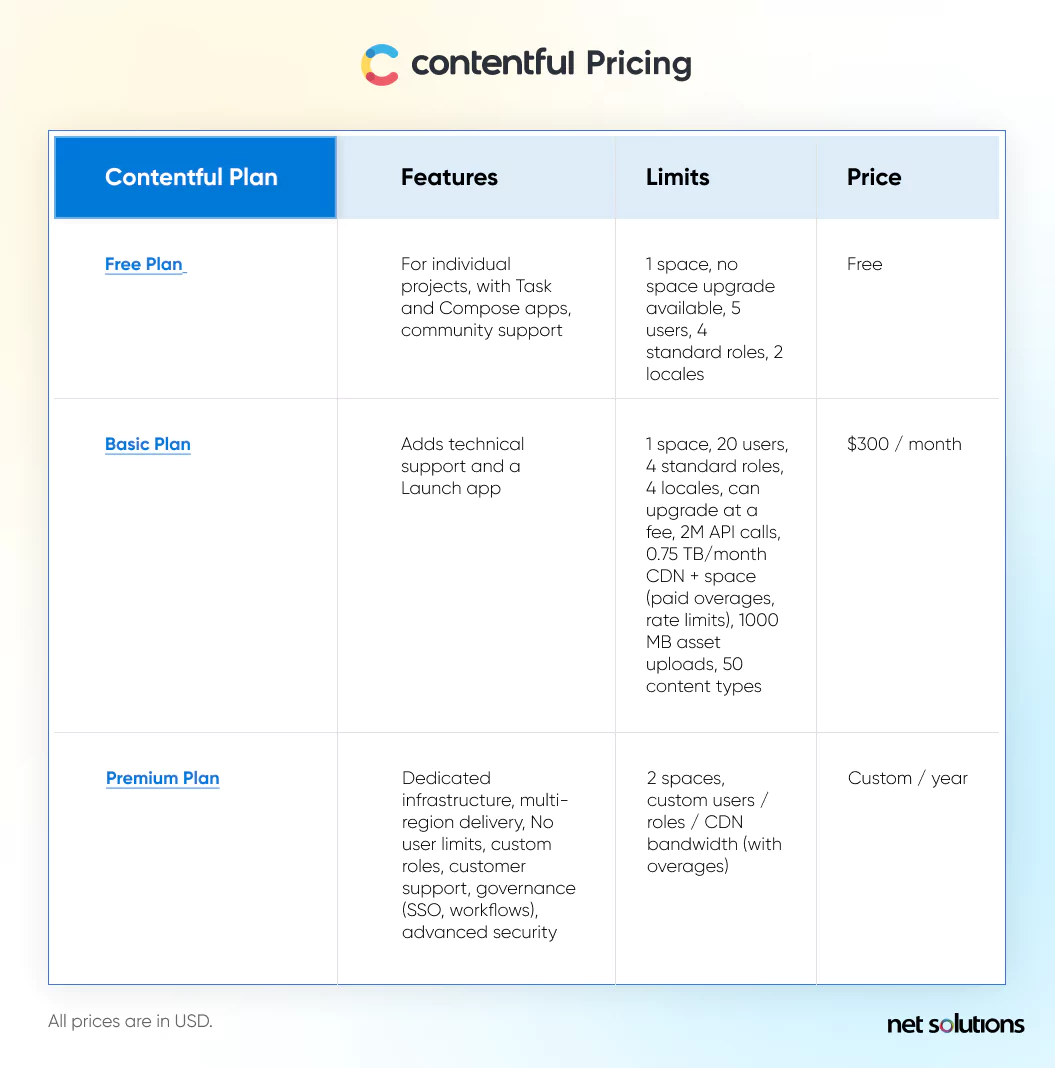
Storyblok and Contentful: Quick Comparison
As Storyblock and Contentful are both headless CMS, sometimes it’s helpful to look more granularly at comparisons.
What are the main differences between Storyblok and Contentful?
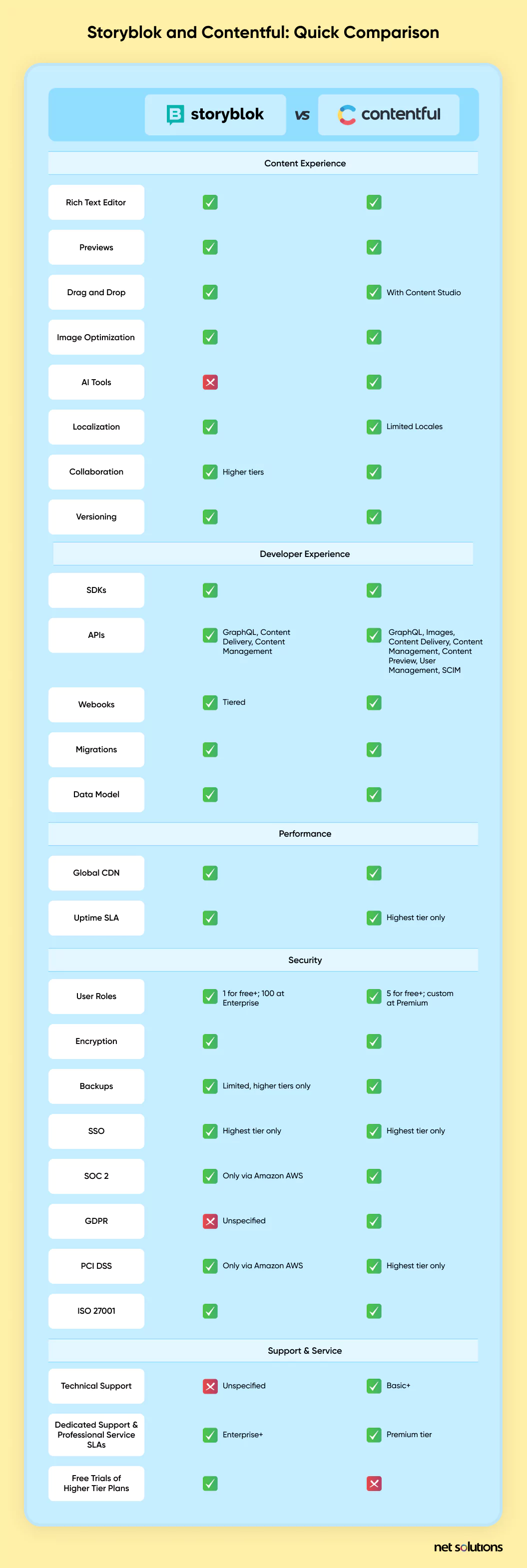
Storyblok vs Contentful: What Users Have to Say
In this unbiased comparison of Contentful vs Storyblock, we will share some reviews from the peer-to-peer review site G2.
What do users have to say about Storyblok?
Storyblok has 404 reviews and 4.5 stars on G2 and was recently named the #2 in G2’s 2024 Best Software Awards for Content Management Products.
Pros:
- “The modular approach allows for effortless content management, while the visual editor streamlines the process, enabling a dynamic and efficient workflow. Additionally, the robust API support and collaboration features contribute to a smooth and collaborative development experience.” – Dimitrios M.
- “The best thing about Storyblok is how customisable it makes websites for both marketing teams adding content to their website and developers writing the code for specific bloks. While most CMSs throw everything at you and you spend time trying to figure out how to build what you are looking, Storyblok passes the reins to the developer who can then create exactly what is needed for the specific website in development. The live preview editor was a key selling point for me, being able to preview how the website would look before deployment was important and a step up from previous custom developed CMSs. As a developer, documentation and easy integration is key for create a website. Storyblok has a plethora of documentation for connecting the platform to a custom built site and I was able to follow along the tutorial for connecting it to a Nuxt application. The fact that all is really needed to connect it is some access tokens makes the implementation very easy.
- For what few questions I have asked via the help section’s chat have had fairly timed responses which were both useful and friendly. The use of a free tier is what made me use it as I could test out the platform and learn how to use without worrying about a payment. Additionally the free tier meant I could host websites and not need to pay until the website was recieving [sic] high amounts of traffic, aty [sic] which point it would be viable to pick a paid plan.“ – Computer Software user
- “As a developer user, what I appreciate most about Storyblok is its seamless and intuitive content management system (CMS). Storyblok’s modular approach to content allows me to create dynamic and engaging websites with ease. The flexibility of its headless CMS enables me to decouple the frontend and backend, giving me the freedom to use any technology stack. The real-time collaboration features also streamline the content creation process, making it easy to work with content editors and other team members. Additionally, Storyblok’s robust API and extensive documentation empower me to integrate and extend functionalities effortlessly. Overall, the user-friendly interface, flexibility, and developer-friendly features make Storyblok an invaluable tool for creating modern and dynamic web experiences.” – Johannes S.
Cons:
- “If there’s one area I believe Storyblok could improve, it’s their support. While it’s not bad by any means, a bit more responsiveness and depth in their support would elevate the overall experience. The discord isn’t particularly active and as a newbie finding answers to things was a bit of a challenge at first — not helped by some documention [sic] that was out of date, although this is apparently being worked on.” – David C.
- “There are challenges in terms of complexity during initial setup, involving understanding stories, spaces, content types, and API usage. There are also challenges with bulk edits, GraphQL API limitations, and an initially overwhelming interface that hinders the ease of use.” – Dimitrios S.
- “I wish storyblok had a more visual approach to sharing blok-schemas across projects. Currently they offer a CLI but the entire approach is relatively hands-on. It’s similar to copy and pasting files in a way, and I think this could be achieved with an inbuilt app-like approach of drag and drop.” – Rafal P.
What do users have to say about Contentful?
Contentful has 299 reviews on G2 and 4 out of 5 stars overall.
Pros:
- “Contentful seems to be very developer-oriented in its in-depth features, and the way they are presented. The new Studio experience seems quite exciting, and should make the solution a lot easier to use.
Integrating the main Contentful API with our website build system was incredibly straightforward.
The support team (once you’re a prospect or a paying customer) are very responsive, quick, and helpful. This even extends to their Engineering team being available to look at issues on their open source repos.” – Oskari G.
- “A list of options and features that are added as part of the cms.
Customer support is a good add on.
Ability [sic] to get integrations and options at a global level.“ – Enterprise user
- “As a content manager, I’ve worked with other CMS systems like WordPress, but Contentful is by far the easiest to use. The interface is pleasant, and I enjoy creating unique structures for each web page or email. I’m not a developer whatsoever, and I found it really easy to navigate and learn.” – Gabriela R.
Cons:
- “I don’t miss too many features of Contentful. But maybe it could improve the massive import and export of content from the app, without using Contentful cli.” – Carles S.
- “There need to be more templates available that teams can take advantage of since it is such a different approach for many people who are used to legacy CMS’ systems. The process to push content changes to a staging environment first to test and then out to production could be more seamless.” – Melissa R.
- “It’s a bit tricky to get an overview of the content tree:
- There is no grouping for Content models. If the use case requires certain type of content models to fall under a group, grouping needs to be hacked using naming conventions that would mimic grouping
- Experimental features sometimes go through breaking pages which would make upgrades tricky. One of the examples is Compose. There were some content model changes for page and page settings which made upgrade to next version a bit tricky.“ – Sports User
The Bottom Line
When you’re looking for the best headless CMS for your project, you have so many options to choose from. Between Storyblok and Contetnful, here’s the kinds of projects you should consider.
What is Storyblok best for?
Storyblok makes it easy to create, manage and enhance personalized content to customers across all channels and devices and across the globe. It is ideally suited to for small or very large projects including:
- Websites
- Digital displays and online guides
- eCommerce
- Mobile optimized websites
What is Contentful best for?
Contentful is ideally suited for both small business and enterprise customers with lots of integrations to make the platform easy to use and scale, especially if you’re willing to pay to access its best features. It’s ideal for the following kinds of projects:
- Websites
- Mobile apps
- Knowledge bases or portals
- Interactive guides
Ready to get started?
If you’re looking to dig further into why Storyblook or Contentful would be right for you—or perhaps get a more comprehensive understanding of all your headless options, our dedicated team of developers, business analysts, UX/UI experts, and designers bring a wealth of industry experience to help you choose the right headless CMS and to explain why it’s right for you.
Net Solutions has vast experience with setting up headless CMS platforms for their customers and is a proud partners with Contentful.

